Not only am I going to teach you the basics of how to become an affiliate marketer, but we’ll also dive into some real examples from professional affiliate marketers who are making thousands or even millions of dollars per year without spending money on PPC or any of that nonsense.
We’ll cover promoting products on Amazon, creating SEO-optimized content that ranks well on Google, email list promotion strategies, how to choose the best affiliate program for you, and give you a step-by-step guide to the whole process, so you’ll be earning affiliate commissions in no time.
Let’s dive in.
What is Affiliate Marketing?
Affiliate marketing is the practice of promoting the products or services of another person or company in exchange for a commission on the resulting sale. Affiliate marketers join affiliate programs, find reputable affiliate products to promote, and then share those products with their audiences.Basically, it’s a modern interpretation of a very old idea — getting a commission on a sale.
If you’ve been listening to us for long, you’ve learned that bloggers make money by building an audience that trusts them, and then offering products or services that will genuinely help that audience.
Affiliate marketing is really just a quick way to offer products and services without having to create your own products and services.
For bloggers, that means you find a product or service that you like, promote it to your readers, and earn part of the profit on each sale that you make.
How Does Affiliate Marketing Work?
Affiliate marketing can get pretty technical, even for those well-versed in digital marketing. Fortunately, you don’t need to know all the details to get started.
The actual mechanics run in the background, thanks to the merchant’s affiliate program software.
But here’s a quick look behind the scenes:
- When an affiliate joins the merchant’s program, he or she is given a unique ID and a specific URL to use when promoting the company’s product.
- The affiliate includes the link in their blog content and/or via their email marketing efforts and invites readers to click it to find out more.
- When a potential buyer clicks on the link to visit the affiliate partners’ site, a cookie identifying the affiliate is placed on their computer. The cookie ensures that the publisher is credited with the referral sale even if it occurs days or even weeks later.
- Whenever a buyer completes the sale process, the merchant checks the sales record for a cookie identifying the source of the referral.
- If the merchant finds a cookie with an affiliate ID, the affiliate is credited with the sale.
- The merchant makes reports available so that the affiliate can see their referrals (clicks) and sales.
- The merchant pays the affiliate commission at the end of each payment period (i.e. revenue sharing).
How to Start Affiliate Marketing in 4 Steps
Here’s the key point you need to understand if you want to become an affiliate marketer:
You’re earning a commission in exchange for giving readers
valuable insights on products or services they were already thinking
about purchasing.
In other words, your readers are already buying things. They are already going to make a purchase whether or not you give them any advice.
The question is, could you help them make a smarter decision than they could alone?
Because that’s where you add value. You earn a commission in exchange
for helping people make smarter decisions, and you use your blog and
the Internet to systemize that process, providing valuable advice to
thousands of people.
Here’s a step-by-step process for doing exactly that:
Step 1: Choose a Product to Promote as an Affiliate
As an ethical blogger, you’ll always be constrained in the products you choose to represent in one of two ways:
- Either you’re limited by your experience to products that you’ve used and liked, that have affiliate programs and that are a good fit for your audience, or
- You’re constrained by the products you can get access to in order to evaluate them, either by buying them outright or getting a free sample or trial.
No matter which approach you take, expect to have to invest time and money into researching the best products for your audience.
Here are your two main options (with your best option listed first).
OPTION #1: PROMOTE PRODUCTS YOU ALREADY KNOW AND LOVE
You become an affiliate for something that you’ve used yourself, had a good experience with, thoroughly tested and feel good recommending. You should be fairly confident that others will get the same results you did (or better), as long as they do the work.
If you’ve found great success from a course, mastermind, or ebook that your readers could also benefit from, it only makes sense for you to spread the word and share your results.
Do an inventory of the products, services, and courses you already have experience with. You might have a list of a dozen or more.
Which of these would you be thrilled to promote? Cross out any that don’t fit the bill.
Now simply check to see if the merchant has an affiliate program (some won’t but you’ll probably be surprised at how many do).
Using a search engine like Google, search for “affiliate program” + [product name], or simply email the merchant and ask.
Then run your remaining options through this Good Affiliate Product checklist:
- You’ve previewed the product so you know its quality (given, in this case).
- They have a solid refund policy that you trust they’ll honor.
- They provide good customer support (and you’ve tested it).
- You have a good story to share about your experience with the product.
- The offer fits your audience’s needs and won’t abuse the trust you’ve built with them.
You’ve found your first product! Apply using the merchant’s process and start promoting.
If you’re just dipping your toe in the affiliate marketing channels, this first option may be enough to get you started.
However, most bloggers will want to try the next one, too.
(And you’ll have to explore the second option if you don’t have an existing product you love that is also a great match for your audience and offers an affiliate program.)
OPTION #2/ FIND PRODUCTS VIA AN AFFILIATE NETWORK
If you don’t have any direct experience with or knowledge of products in your niche that could help your readers, you can often find good affiliate products on affiliate networks.But be careful — this approach requires that you invest time into research and money into purchasing products to try out, more so than the first option.
That’s because there’s less trust and prior knowledge involved from the outset. You have to do your due diligence to protect your reputation and the credibility you’ve built with your readers.
When you work through a network, you typically won’t know the merchant ahead of time and usually won’t build a relationship with them (your business relationship is with the network).
The list of popular and reliable affiliate networks include ClickBank, CJ Affiliate, the eBay Partner Network, ShareaSale, and the Amazon Associates program. Some networks will even assign you an affiliate manager to lend a hand and show you the ropes.
Amazon products, in particular, are an easy way to get started. Many newbies begin by becoming an Amazon affiliate and then scaling to other types of more profitable affiliate offers.
Step 2: Get Yourself Set Up as an Affiliate
Whether you work directly with a merchant or through a network, you’ll have to apply, be approved and provide certain information so that you can be paid.At a minimum you’ll need to provide:
- Your personal/business contact information for tax and reporting purposes.
- Your bank account where commissions will be sent.
- An affiliate link. Whenever you post about the product, you’ll use this trackable link. It will have a long tag at the end of each link that includes your affiliate ID.
These could include:
- An affiliate guide as well as instructions on how to use the platform and summary of policies such as payouts.
- Online marketing tools like banners and sidebar graphics.
- Sample email/webpage swipe copy.
- Ongoing communications from the merchant about promotions, new products, etc.
Be sure to check your specific network’s help or support pages for more information.
Tip: If your audience is global (which many bloggers’ are), you might want to check out geniuslink for tracking overseas sales through Amazon, iTunes, and Microsoft Store.
Step 3: Start Promoting Your Chosen Affiliate Offers
Ultimately, all your hard work finding and evaluating products only pays off if somebody takes your advice and make the purchase, right?
For that to happen, you need to put your recommendation in front of
your audience. Even more importantly, you need to make your
recommendation trustworthy.
But take a look at this:
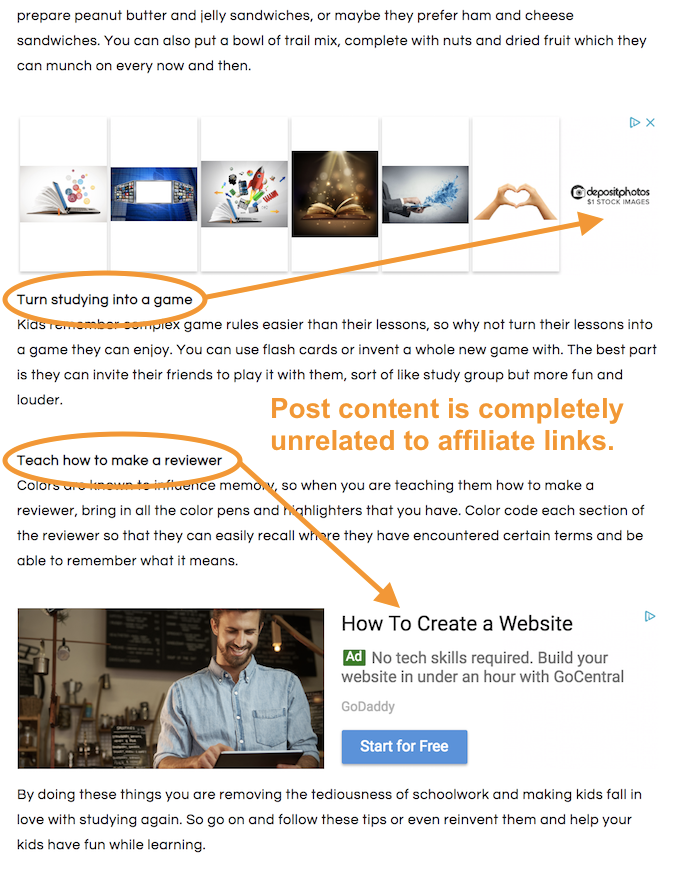
Does that look trustworthy to you? Nowhere close, right?
Well, here’s a little secret:
The most successful affiliate offers look nothing like that. No PPC or veiled recommendations on social media.
Here’s what to do instead (and what marketing channels to use):
Option #1: Create a Resource Page on Your Blog
A resource page that promotes lots of different products, but it also organizes them according to different types of readers and what they might need at the time. It also explains why those products would be helpful to them.In other words, it’s not just a sales pitch. It’s educational. Because it contains a lot of content, plus it’s well optimized for SEO, it also ranks well on Google and gets organic traffic.
Chances are, you can put together a landing page like this within a few hours. Your readers will also appreciate you putting all of your recommendations in one place for easy reference.
Option #2: Create and Promote Custom Content
This content marketing strategy will be the backbone of your affiliate promotional efforts.
Use as many of the following different techniques as make sense for your blog and audience.
Note: All of these strategies assume that you are
already sending traffic to the latest content you’re creating by
emailing your list on a regular basis (at least two to four times per
month) to let them know what’s new.
A) Write Reviews
You can write detailed reviews of products, courses, books or software products you promote as an affiliate.
Your reviews can focus on a single product or compare competing products side-by-side.
The second approach arguably builds more trust, but it also distracts people by giving them a lot of different recommendations.
If you would like to review multiple products, one option is to create a
review site where all the content is simply reviews and affiliate
offers. It becomes a “one-stop shop” for your niche.
B) Write Definitive Content on a Related Topic
You can write a definitive, comprehensive post on your site to educate
your readers and “soft sell” your products and then work to get it
ranking in the search engines.
For instance, you could write an ultimate guide to setting up a WordPress blog and include your affiliate links to your favorite hosting providers.
Whatever the topic, make sure that it’s evergreen content — information that’s likely to be useful and valuable for years to come.
You can create blog posts, videos, infographics or anything similar — but whatever you do, it should not be a sales page. Focus on building trust and authority.
Finally, you should pay a lot of attention to SEO — make sure to optimize for the right keywords, keep WordPress running fast, and build links to your content to get a constant flow of traffic from Google.
C) Create Valuable Bonus Content
Assuming it’s allowed by your affiliate agreement (sometimes it’s not), you can create bonus content, exclusive to your readers, that helps people get even more value from the affiliate product.People love bonuses! You can create many types of bonuses fairly quickly and easily while still giving your readers excellent value.
By the way, this is a fantastic way to differentiate yourself from other bloggers representing the same products.
Here are some example bonuses you could offer:
- Step-by-step checklists
- Quick-start guides
- Video overviews or demos
- Complementary or discounted services (e.g., coaching calls)
Step 4: Comply with Legal Requirements (and Best Practices)
In the U.S., the Federal Trade Commission (FTC) requires that you let people know you’ll earn a commission.
But even if it isn’t required by law where you’re located, we recommend it. It’s just good business.
Don’t be afraid to be transparent. People will appreciate your honesty and want to support you to repay you for making their lives better.
So wherever you share an affiliate link, whether it’s in blog posts, web pages, or emails, let your readers know that you stand to earn a small commission if they buy through you — and if they choose not to use your link, no worries.
Assure them that you wouldn’t recommend any products if you hadn’t used them yourself or were confident they could help them.
It’s also a good idea to create an Affiliate Disclaimer page on your website.
Affiliate Marketing Examples: 4 Types of Affiliate Products to Promote
So, we’ve walked through the process of becoming a successful affiliate marketer. Now let’s step through some real-world affiliate marketing program examples, walking through four different types of products you can promote and make a tidy profit.Usually, most of your affiliate income will come from one or two “ringers” — core products that just about everyone in your audience needs and which also pay a good commission.
As you progress, you can add complementary products to round out your offerings and help your audience in new ways, but identifying your core earners is an essential first step.
Option #1: Digital Downloads
Digital downloads are online resources that your readers can access instantly, without having to wait for a package to come in the mail (as is true for physical products).They could be audio or video files, PDFs, ebooks or even links to webpages where the content lives online.
Examples:
- Books or ebooks — Books that are either self-hosted on your merchant’s website or downloaded from Amazon, iBooks, or other online sellers.
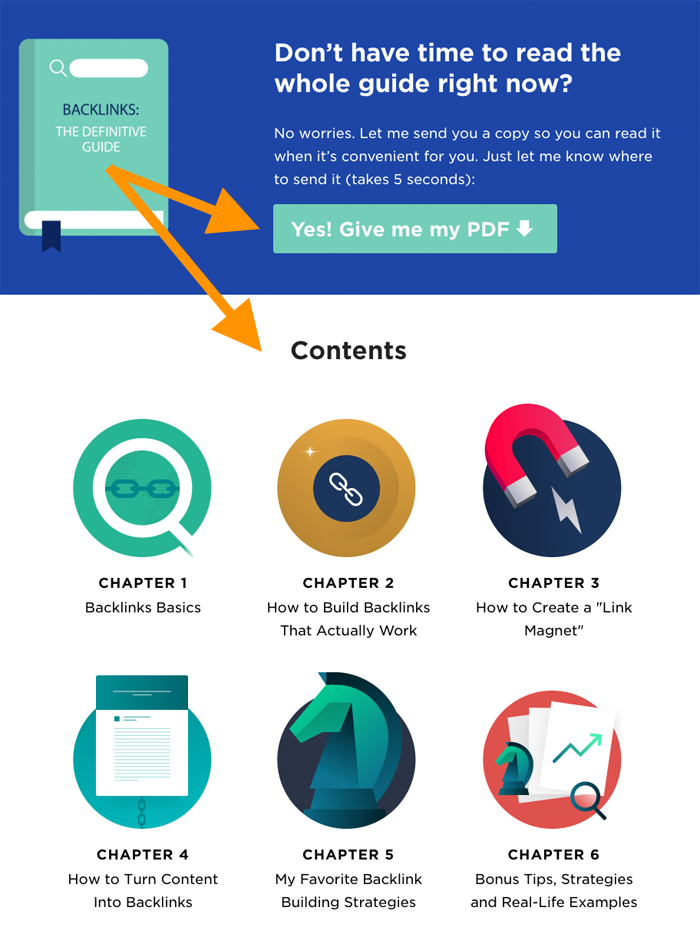
- Software — Downloadable programs, games, apps, plugins and cloud services.
- Mobile applications — Some of the hundreds of apps that are available through the iTunes Affiliate Program and other mobile app affiliate networks.
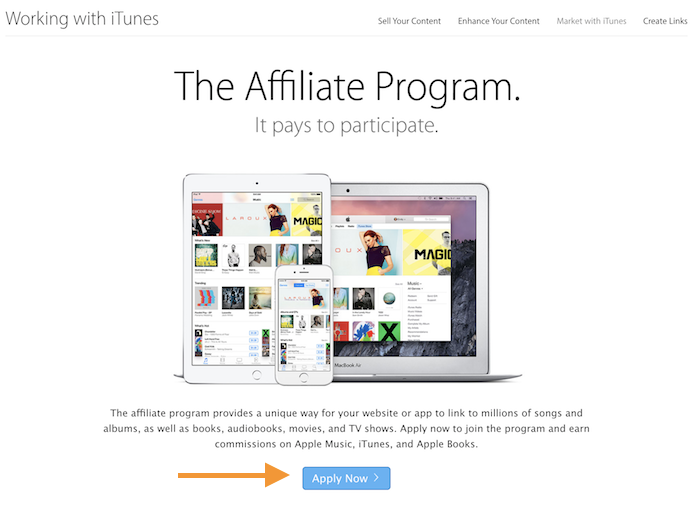
- Music, movies, TV shows, and more — Media offered through Amazon as well as the iTunes Affiliate Program and others.
Our recommendation:
Do it! But expect higher earnings from other options on this list.
Option #2: Online, Hosted, and Professional Services
When it comes to selling services as an affiliate, it’s important to concentrate on those which will be accessible to your entire audience no matter where they’re located (as opposed to service providers who serve local customers only).In other words, don’t limit your earning potential by geography.
Your best bet is to represent online, hosted, or professional service providers/influencers you’ve worked with in the past and have full confidence in.
Examples of professional services:
- Designers (99 Designs, Zazzle, Designmodo)
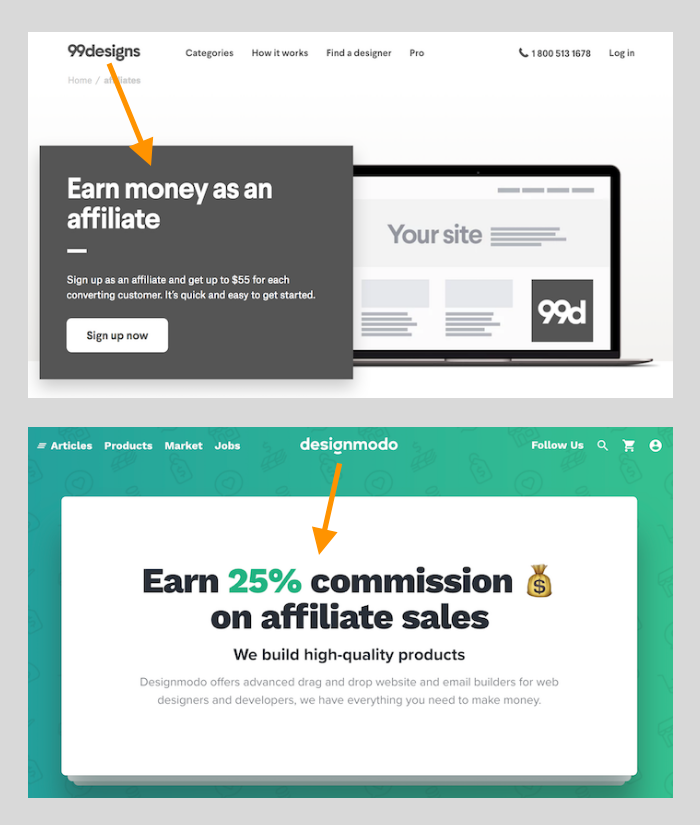
- Media or creative businesses (Media Content Advantage, John Melley Voice Overs & Production, Music Radio Creative)
- Content marketing services (Sprout Social, Hootsuite)
Option #3: Online Courses
Online courses are an important subset of digital products, especially for bloggers, and the market is huge. They’re so popular that they deserve their own category on this list.Online courses exist on just about any topic you can think of. They range in price from free to thousands of dollars, with higher-priced programs promising big results for students.
Examples:
- My Garden School
- Peaceful Parent, Happy Kids – How to Stop Yelling and Start Connecting
Option #4: Ecommerce Stores
If you decide to promote physical products on your blog, your best bet is to choose high-quality, distinctive products that that will appeal strongly to your specific audience.Avoid commodity products that your readers can buy anywhere — the commissions are so small you won’t make worthwhile money unless you can drive tremendous traffic to your site.
Commissions on ecommerce products are usually fairly low because of the overhead of production costs, storage costs, shipping, etc. So unless you are planning to build a large review or shopping site, physical products will probably be a very small portion of your blogging affiliate income.
However, if you have a favorite tool of your trade, a must-have gadget that will make your readers lives easier, or a high-quality recommendation that you’re sure people will be thrilled with, go ahead and offer it.
You’ll build goodwill even if you don’t make a lot of money.
Examples:
- Niche shopping — Product Review Mom (parenting), Compost Mania (gardening), Roemer’s Workshop (hobbies), Pinch of Yum (food)
- Tech or gadgets — Engadget, Gizmodo, Craziest Gadgets

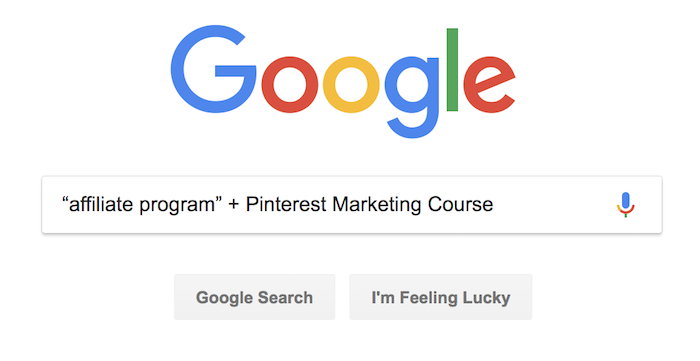
Comments
Post a Comment